A stroll through L.A.’s oasis
May 30, 2012
What do tree frogs, bobcats and woodpeckers know that you don’t? They all love to hang out at spring-fed Fern Dell in Griffith Park. And this Saturday, June 2, Friends of Griffith Park, a non-profit restoration group, wants to let you in on the secrets of this verdant oasis with a free, guided tour.
Fern Dell and its year-round waters have attracted visitors since pre-European Gabrielino-Tongva peoples held tribal meetings there. In the early 20th century, the ravine was transformed into a popular recreational area, complete with ferns, picnic areas, footbridges and terraces.
Unfortunately, the area fell into disrepair over the decades. Invasive plants, graffiti and fern thieves have removed some of the luster from what was once an urban gem. Friends of Griffith Park is in the process of trying to restore the sanctuary, as recently documented by KCRW and the Los Angeles Times. According to group organizer Gerry Hans, the first step in that restoration will be completed when consultants report back with an official assessment of the park. Then, a specific rehabilitation plan will be developed.
Even in its current state, Fern Dell functions as a hotspot for wildlife, while also providing a quiet place for park-goers to explore nature.
The two-hour tour begins at 9 a.m. with coffee and pastries. Volunteers will share facts about the history of Fern Dell and talk about plans to restore it. The expedition meets behind Fern Dell’s Trails Café. To join, RSVP with the number in your party to [email protected]. Parking is available on the street or in the Western Canyon upper lots.
Posted 5/30/12
This summer’s “grand” opening
May 29, 2012
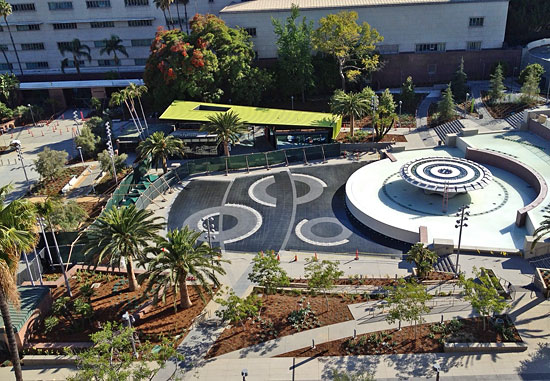
This section of Grand Park, featuring the Arthur J. Will fountain and green-roofed Starbucks, will open first.
The newly named Grand Park in downtown Los Angeles edged closer to reality this week, with the selection of the Music Center as operator of the 12-acre site, now scheduled to begin opening in late July or early August.
The park, which until this week had been called Civic Center Park, promises to dramatically reshape a downtown experience that, for decades, has offered little in the way of outdoor recreation or entertainment. When completed, Grand Park will stretch four blocks—from the Music Center to City Hall—and will feature, among other things, an event lawn, gardens, walking paths and spectacularly renovated fountain (see video here).
Project Manager Dawn McDivitt of the county’s Chief Executive Office said the park’s opening will be phased in throughout the summer. The park’s northern end, which includes the Arthur J. Will Memorial Fountain below Grand Avenue, should be opened in roughly two months. McDivitt said the strategy of staggered openings will give the event lawn at the park’s southern end time to take root—and for the county to create excitement around the unveiling of each successive stage.
With the first opening only weeks away, the Board of Supervisors on Tuesday voted unanimously to contract with the Performing Arts Center of Los Angeles—more commonly known as the Music Center—to oversee park operations for the first three years. That includes lining up a diverse slate of musical, theatrical and educational programming.
“We look forward to working with the county to create a vibrant and welcoming park in the center of downtown,” Music Center Chief Executive Officer Stephen D. Rountree said after the board’s vote. He said that no firm programming decisions have been made but that he expects year-round activities ranging from music festivals to farmer’s markets.
The supervisors also voted to change the name to Grand Park. Planners were worried that the phrase “civic center” was not sending a clear message. “We didn’t want it to sound too governmental or too institutional,” McDivitt said. “We wanted the name to reflect the park’s aspirations.”
The park is part of the larger Grand Avenue project, a massive commercial and residential development that has stalled with the faltering economy. The developer was required to provide $54 million upfront toward the park, thus ensuring its completion.
Posted 5/26/12
Orange Line, golden age
May 29, 2012
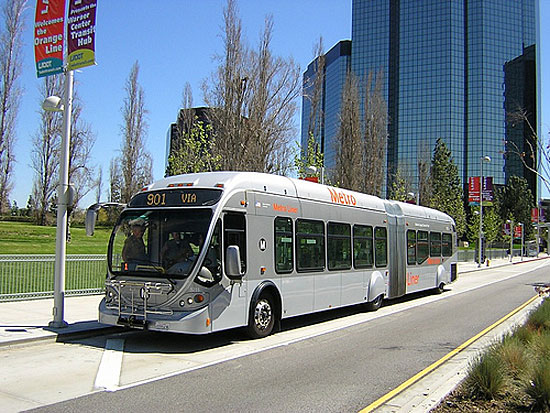
Starting June 30, the Orange Line Extension rolls northward as part of the county's public transit boom.
Sometimes it’s hard to spot a great leap forward when you’re sitting in bumper-to-bumper traffic.
But that’s what we’re living through these days in L.A. County.
Our public transportation system, a national laughingstock just a generation ago, is on a roll. I don’t think it’s an overstatement to say we’ve entered a golden age of public mass transit. I’m not arguing that our notorious traffic congestion is likely to disappear anytime soon; as long as our population keeps growing and 16-year-olds continue to head down to the DMV to get their first driver’s licenses, that’s going to be a fact of L.A. life. But we’re finally in a position to offer the traveling public some meaningful alternatives to sitting and stewing on our freeways and surface streets.
The Orange Line Extension is the latest case in point. This rapid transit bus line opens to the public on Saturday, June 30, with free rides and festivities. Its four-mile route, which runs from Warner Center to the Metrolink train station in Chatsworth, is a northward extension of the original Orange Line, which opened in 2005 to rave reviews and significantly higher-than-projected ridership. (It now stands at more than 25,000 boardings a day.)
The Orange Line Extension—which is coming in under budget and ahead of schedule—promises to continue that success story, offering thousands of new riders not just a better commute but a better quality of life.
As important as this project is to bringing transportation alternatives to our traffic-jammed region, it’s only a small part of what’s now happening across Los Angeles County. Look in just about any direction, and you’ll see signs of a transit revolution.
The long-held dream of building a Westside Subway moved into high gear last week as Metro’s Board of Directors voted to approve the project’s route, placing it on track to break ground as early as 2013.
Meanwhile, the Westside’s first light rail since the Red Car is now open for business. The Expo Line started carrying passengers between downtown and La Cienega in April, and will be reaching Culver City later this summer. Work also has begun on Expo’s second phase, which will extend the line all the way to Santa Monica.
On the other side of the county, the eastward expansion of the Gold Line is underway, with a dramatic bridge taking form across the 210 Freeway as the light rail rolls ahead toward Azusa. And projects ranging from the Crenshaw/LAX Line to the Regional Connector are moving closer to becoming a reality.
These projects—many of them made possible by county voters’ overwhelming approval of Measure R in 2008—are about so much more than moving us from Point A to Point B. Every time we build a mass transit alternative, we return precious time to the daily lives of real people. We restore choice to commuters who have been held hostage to the freeways. And we move our region toward a healthier, less car-dependent future.
I encourage you to hop onboard the Orange Line Extension when it opens June 30. And be sure to take a photo. You can say you were there as L.A. was making its move from public transportation punch line to public transportation powerhouse.
Posted 5/29/12
A Memorial Day to remember
May 25, 2012
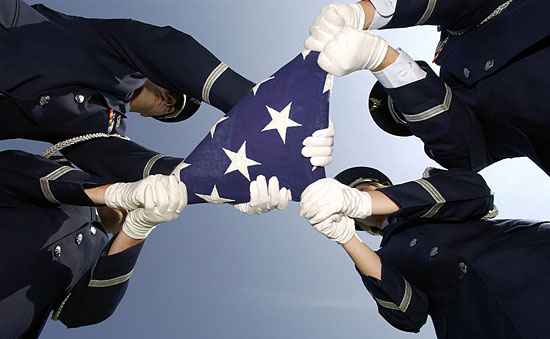
Another summer is upon us, as marked by our upcoming three-day weekend. No doubt, there’ll be lots of department store sales and plenty of backyard barbecues. But too often lost in the Memorial Day festivities is the holiday’s more somber meaning—a day of remembrance for those who’ve died in the nation’s service.
For so many families among us, the wounds of loss are fresh and deep. During the past decade, more than 6,400 men and women have died in Iraq and Afghanistan. My prayers go out to their heartbroken loved ones. The trauma, of course, does not stop there. At this moment, thousands upon thousands of others are struggling mightily to overcome debilitating trauma to their bodies and minds.
I hope you can find a few minutes to commemorate Memorial Day. To help you, the county’s Department of Military and Veterans Affairs has compiled its annual comprehensive list of events, including many that offer special discounts to members of the military and their families. Maybe one way to recognize those who’ve perished in our recent wars is simply to explore the Washington Post’s excellent Faces of the Fallen. Among my plans for the day, I’ll be at the Canoga Park Memorial Day Parade.
My fondest hope is that those individuals now bravely serving in danger zones across the planet will return to us safely so that next year we can celebrate, rather than mourn, them.
Posted 5/25/12
Westside Subway’s officially on its way
May 24, 2012
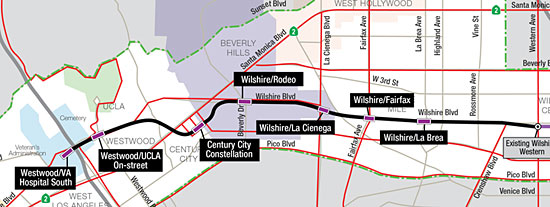
The subway, an extension of the Purple Line, will feature 7 new stations along a 9-mile route. Graphic/Metro
Despite threats of litigation from Beverly Hills, Metro’s board of directors sent the long-anticipated Westside Subway heading down the tracks on a route that includes a controversial station on Constellation Boulevard in Century City.
The Metro board, which had previously approved the subway’s first segment, voted Thursday to give final approval to the line’s second and third phases. When completed, the $5.6 billion subway will extend Metro’s Purple Line from Wilshire and Western to the Veteran’s Administration in West L.A.
“It will be the first mass rapid transportation project for Westwood and Beverly Hills and Century City and the Miracle Mile in history—something that the area has longed for for a very long time,” said Supervisor Zev Yaroslavsky, a member of the Metro board.
The board’s vote came over sharp objections from some Beverly Hills officials, including school board member Lisa Korbatov, who warned: “You’re careening headlong into a lawsuit…I’m telling you here and now: you will not succeed. We will stop you at every turn. You will be litigated.”
Beverly Hills officials have objected to the placement of the Constellation station because plans call for tunneling under the campus of Beverly Hills High School to get there. They argue that such tunneling could pose safety risks and interfere with future development on the school grounds—concerns that Metro says are unfounded.
Thursday’s landmark vote came a week after a special hearing in which Beverly Hills aired its objections to the subway plans, presented the findings of its own scientific consultants, and offered three alternate routes.
But Metro stood by its own experts, and said the Beverly Hills proposals for the alternate routes were not feasible.
Many members of the public showed up to support the project route that included the Constellation station. The first speaker got things going with an exhortation to “dig, baby, dig!”
The board voted 7-2 in favor of the project, with Michael D. Antonovich and John Fasana opposed. The vote clears the way for Metro to seek federal approvals to create final design and engineering plans for the project. Construction could begin as early as next year. Under the current timetable, the first phase of the project from Western Avenue to La Cienega would be completed by 2020, with the line reaching Century City in 2026 and Westwood in 2036. Efforts to accelerate that timetable are underway.
After the vote, Yaroslavsky said he still holds out hope that there can be “a meeting of the minds” between Metro and Beverly Hills.
“It’s a safe project,” Yaroslavsky said. “The people of Beverly Hills and the parents of the school kids in Beverly Hills should rest assured that this can be built without any jeopardy to that school and certainly to the kids in that school.”
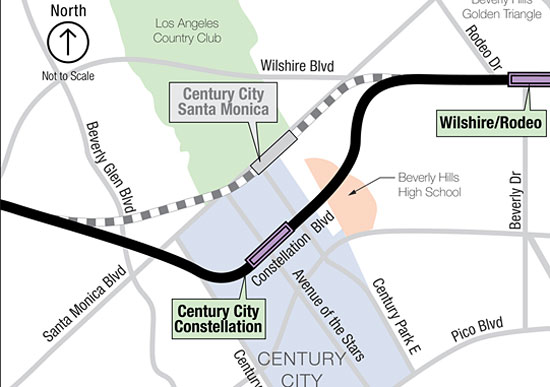
The heavy black line shows the route the subway will take to the Constellation station. Graphic/Metro
Posted 5/24/12
County braces for a wave of L.A. ink
May 24, 2012
Since 1998, Roger “Rabb!t” Rodriguez has been a professional body artist. Piercing, tattooing, branding—he’s seen it all. But in all his time in Greater Los Angeles, in studios from West Hollywood to Pasadena, there’s one thing he has yet to encounter: A health inspection.
That’s about to change this summer.
Starting July 1, California counties will begin enforcing comprehensive state standards for tattooing, body piercing and permanent cosmetics. The Safe Body Art Act, passed in October, is expected to finally bring some uniformity to a municipal patchwork that for decades has hindered widespread regulation of the burgeoning body art industry.
Public health officials applaud the measure, as do most established artists because unsafe practices in piercing and tattooing can lead to HIV and hepatitis. But the new law also promises to dramatically ramp up enforcement, and at the Department of Public Health, the county’s tiny Body Art Unit is braced for big changes.
“This is probably going to quadruple our workload,” says Cole Landowski, head of the county’s environmental hygiene program.
Once a sign of rebellion, tattoos and piercings have increasingly become mainstream, adorning bodies of all ages. Celebrities have taken the industry upscale, and even reality TV has gotten into the act, chronicling the exploits of high profile artists such Los Angeles’ Kat Von D.
Oversight has struggled to keep pace, however. Until this year, California law mandated only that body art businesses register with their respective counties and receive a copy of sterilization and sanitation guidelines.
Counties were free to impose ordinances that went further, but most didn’t. Riverside County, for instance, didn’t regulate body artists until last year, after its lack of enforcement was taken up by a grand jury. Meanwhile, efforts to legislate minimum statewide standards repeatedly failed amid arguments that such regulation would drive away businesses.
Assemblywoman Fiona Ma (D-San Francisco), who helped push through the new law, noted after it passed that manicurists “need 400 hours of training before they can cut your nails, yet until [now], tattooists and piercers have had no training requirements to stick a needle in you.”
Los Angeles County was, for many years, one of the few to regulate piercing and tattoo parlors. “We’ve recognized this as a public health issue for a long time,” says Terri Williams, assistant director of the Environmental Health Division of the Department of Public Health.
The county passed an ordinance in 1999 requiring practitioners to not only register, but also obtain a county health permit and receive blood-borne pathogen training. Facility owners also had to obtain health permits and adhere to standards of design, maintenance and sanitation.
But the county ordinance only extended to unincorporated areas and the 14 smaller cities that opted into the county requirements. The rest of the county’s 88 cities, including the City of Los Angeles, had little, if any regulation beyond business licenses and zoning restrictions.
“I’ve been doing this for 14 years professionally and at no time do I ever recall being inspected,” says Rodriguez, a nationally known piercing artist whose current shop, Ancient Adornments, is a West Hollywood fixture.
Rodriguez’ various workplaces were outside the county’s jurisdiction, but even within it, enforcement was a challenge. At last count, some 480 facilities were licensed in the unincorporated county and contract cities, Williams says, and those are just the ones operating in the open. Rodriguez and others note that many more body artists work underground, setting up un-permitted shop in homes and barrooms.
The three environmental hygienists doing body art regulation must squeeze between 10 and 25 inspections a month into their other duties, which range from noise and odor complaints to asbestos and mold inspections.
“Our hands are pretty full—actually, they’re really full, ” says Francis Pierce, who does most of the county’s body art inspections. (For the record, Pierce has no tattoos or piercings, although he jokes that “several hundred people have offered to do it, for free, even, but what can I say? I’m 53 years old and I have no tats.”)
Now comes the new law, which will require body artists from throughout the county not only to obtain health permits by July 1, but also to renew them annually instead of every three years.
County public health officials know they’ve got a huge challenge ahead of them, given the size of the Body Art Unit and the mounting numbers of establishments that will require inspections. The unit will be responsible for every city except Pasadena, Long Beach and Vernon, which have their own health departments. That means the unit could see its caseload quadruple to as many as 2,000 establishments covered by the new law.
“We suspect that we’ve just been hitting the tip of the iceberg, as it is,” says Landowski. “Who knows what we’re going to run into in the cities? Some of those parlors in Hollywood are the size of postage stamps. Then there’s Venice. . .”
Still, Williams says she’s confident her squad, which she expects to grow by five staffers, can handle the job. Already, the department has been assembling a database, putting together registration packets for establishments and artists, hosting training sessions and doing outreach.
“We’re going to do this well, and be organized in what we do,” she says. Admittedly, it will take time (“They may not all show up saying, ‘Yoo-hoo! We’re here for our health inspection!’”), and everything might not get done before July 1.
But, she says, “we’re looking forward to a positive working relationship. In my experience, it’s a very cooperative industry.”
Rodriguez, the body artist, says he welcomes the scrutiny.
As a member of professional organizations and a former emergency medical technician, he has made scrupulous sanitation his hallmark, but resents being undercut by competitors who endanger the public with careless work and subpar jewelry.
“A lot of artists have no clue,” he says. “They’re just Joe Schmoe, working at a tattoo shop. Putting the public first—that’s what the benefit of this law is going to be.”
Posted 5/24/12
The silver screen’s great escape
May 23, 2012
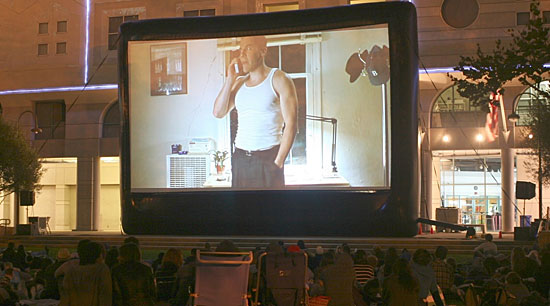
Outdoor movies, like this 2010 screening of "Swingers" downtown, are popping up all over L.A. this summer.
Even as movies shrink to fit onto our computers, tablets and smart phones, Tinseltown seems to be thinking big this season, with outdoor movie screens popping up all over greater Los Angeles. With Memorial Day weekend marking the unofficial start of summer, this might be a good time to turn off the iPad, stretch out on a picnic blanket and start making plans to share a little cinematic magic under the stars.
Perhaps the highest-profile al fresco offerings come from none other than the Academy of Motion Picture Arts and Sciences. The inaugural season of “Oscars Outdoors” debuts this June in a brand new open-air venue complete with a 40-foot by 20-foot screen. The Academy hopes the film series will give audiences a more social movie-going experience.
“The idea of having an outdoor screening facility, which could offer an ‘outside the box’ approach to our screenings and programs, seemed like a wonderful way to return the feeling of community to movie-going,” said Randy Haberkamp, Managing Director of Programming, Education and Preservation.
The season kicks off with the Casablanca on Friday, June 15, and goes on to feature other classics like Shane and A Star Is Born, in addition to more recent fare like Ferris Bueller’s Day Off, Dreamgirls and Jim Henson’s The Dark Crystal. The season concludes Saturday, August 18 with a “sing-along” screening of The Wizard of Oz. Tickets for non-members are $5.
Another new outdoor movie series is “Eat/See/Hear,” which takes its shows on the road using cutting edge technology, including a three-story inflatable screen (“the largest west of the Mississippi,” boasts its website). As the name implies, the shows offer more than movies.
“We have this amazing weather and we’re the city that started the food truck revolution, so we thought, ‘Let’s mash up food with the movies and throw in some of the best local bands,’ ” said Sharon Sperber, co-producer of the events, which are presented by the online movie ticketing company Fandango.
Eat/See/Hear’s 2012 program kicks off at Santa Monica High School this Saturday, May 26, with Anchorman, music from Islands and The Diamond Light and 10 different food trucks. From there, the show travels to Pasadena, Brentwood, North Hollywood, Beverly Hills and other locations in the area. General admission is $10.
Other ways to get your outdoor film fix this summer include free programs such as Movies on the Green at the Valley Cultural Center and the Old Pasadena Film Festival, which will screen classics and family-friendly films over four weekends in July.
Not all the outdoor movie programs are newcomers. For the past decade, Cinespia at the Hollywood Forever Cemetery has been showing vintage films and cult classics, projecting them onto the white marble wall of Rudolph Valentino’s tomb. Cinespia’s 2012 schedule is already underway, with Sabrina and Grease coming up this weekend, on Saturday, May 26, and Sunday, May 27, respectively. A $10 donation is requested.
Another quintessentially L.A. outdoor movie-going experience takes place at the Hollywood Bowl, where audience members, many of them in costume, can sing along as Grease and The Sound of Music are screened, on July 14 and Sept. 22 respectively. Tickets start at $9.
The world’s entertainment capital has never been mistaken for a small town, but as this summer’s outdoor film bonanza rolls out, it just might feel like one. See you at the movies!
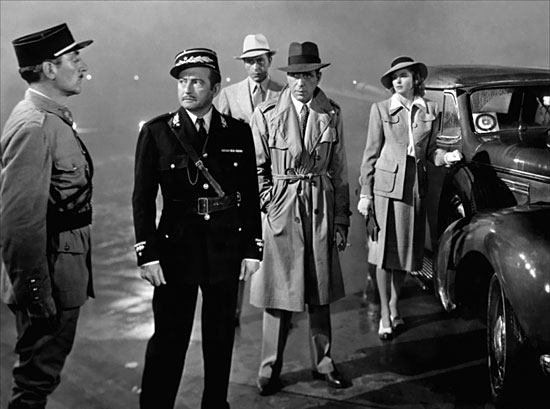
Ilsa, Rick and the whole "Casablanca" gang will be part of the Academy's outdoor summer film series.
Posted 5/23/12
Night closures ahead
May 23, 2012
Segments of the 405 will close overnight next week to accommodate construction activities associated with Metro’s I-405 Sepulveda Pass Improvements Project.
Preliminary closures of some southbound lanes between Getty Center Drive and Sunset Boulevard will begin around 10 p.m. on Tuesday, May 29, with all southbound lanes slated to close from midnight until 5 a.m. Wednesday. The pattern will be repeated with the northbound lanes between Moraga Drive and Getty Center Drive starting at 10 p.m. Wednesday, with full closures of all northbound lanes from midnight through 5 a.m. on Thursday. Traffic will be detoured to surface streets during the closures.
The overnight closures are the latest to hit as the 405 Project pushes towards completion in 2013. When finished, the project will add a 10-mile northbound carpool lane, widen existing ramps and bridges, and improve the supporting infrastructure of the notoriously congested freeway. Keep tabs on the project with the 405 Report.
Posted 5/23/12
Honoring those who served
May 23, 2012
From parades and pageantry to solemn ceremonies and candlelight vigils, there are many ways to pay tribute to fallen members of the U.S. Armed Forces this Memorial Day weekend in Los Angeles County.
In addition, active duty, returning and retired personnel are being honored at events including the 2nd annual “Walk for Warriors” at the V.A. campus in West Los Angeles on Monday, May 28. They also can enjoy free admission to attractions such as the Queen Mary and Knott’s Berry Farm.
The Los Angeles County Department of Military and Veterans Affairs has compiled a list of this year’s options for services and other Memorial Day weekend events in communities across the region. Click here to find out how to make this a weekend to remember—in the best sense of the word.
Posted 5/23/12







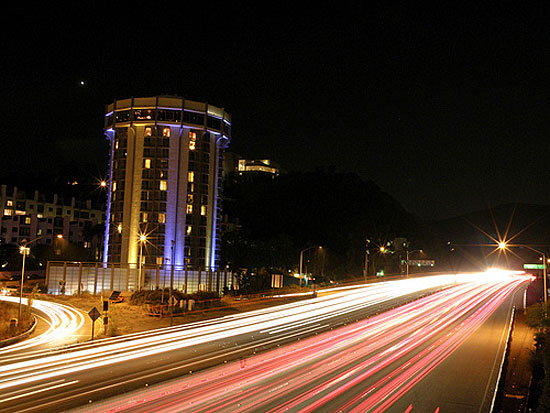






 Check for the latest closure information
Check for the latest closure information








